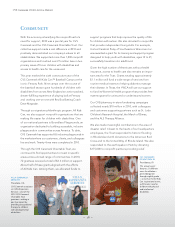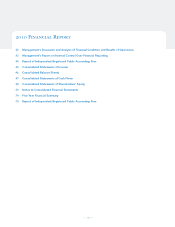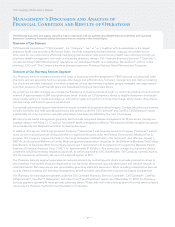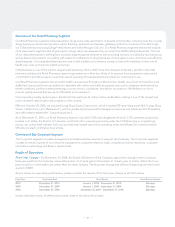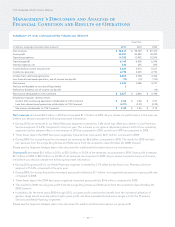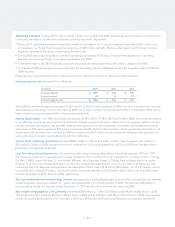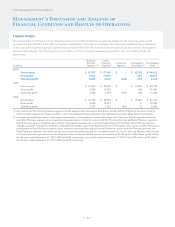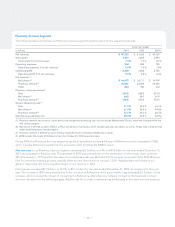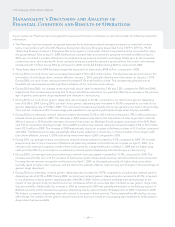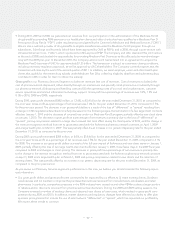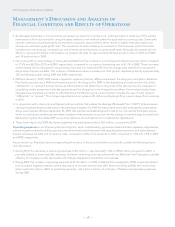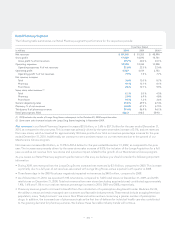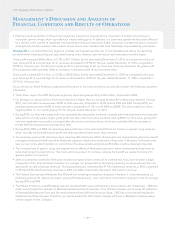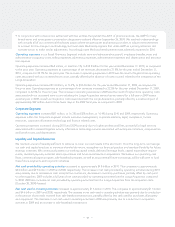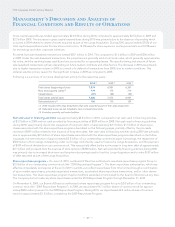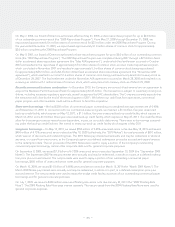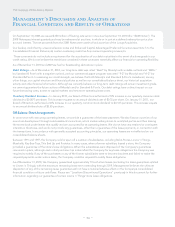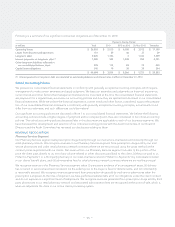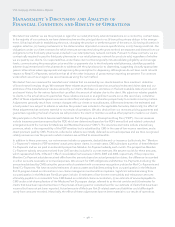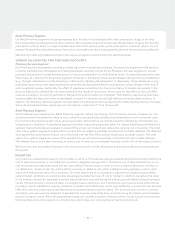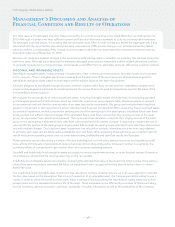CVS 2010 Annual Report Download - page 32
Download and view the complete annual report
Please find page 32 of the 2010 CVS annual report below. You can navigate through the pages in the report by either clicking on the pages listed below, or by using the keyword search tool below to find specific information within the annual report.
Management’s Discussion and Analysis of
Financial Condition and Results of Operations
• As discussed previously in this document, we review our network contracts on an individual basis to determine if the related
revenues should be accounted for using the gross method or net method under the applicable accounting rules. Caremark’s
network contracts are predominantly accounted for using the gross method, which results in higher revenues, higher cost
of revenues and lower gross profit rates. The conversion of certain RxAmerica contracts to the Caremark contract structure
increased our net revenues, increased our cost of revenues and lowered our gross profit rates. Although this change did not
affect our gross profit dollars, it did reduce our gross profit rates by approximately 40 basis points in each of 2010 and 2009,
and 35 basis points in 2008.
• Our gross profit as a percentage of revenues benefited from the increase in our total generic dispensing rate, which increased
to 71.5% and 68.2% in 2010 and 2009, respectively, compared to our generic dispensing rate of 65.1% in 2008. These increases
were primarily due to new generic drug introductions and our continued efforts to encourage plan members to use generic
drugs when they are available. The inclusion of RxAmerica claims increased our total generic dispensing rate by approximately
120 and 20 basis points during 2009 and 2008, respectively.
• Effective January 1, 2010, CMS issued a regulation requiring that any difference between the drug price charged to Medicare
Part D plan sponsors by a PBM and the price paid for the drug by the PBM to the dispensing provider (commonly called
“differential” or “spread”) be reported as an administrative cost rather than a drug cost of the plan sponsor for purposes of
calculating certain government subsidy payments and the drug price to be charged to enrollees. As noted previously, these
changes have impacted our ability to offer Medicare Part D plan sponsors pricing that includes the use of retail network
“differential” or “spread.” This change impacted both our gross profit dollars and gross profit as a percentage of net revenues
in 2010.
• In conjunction with a class action settlement with two entities that publish the Average Wholesale Price (“AWP”) of pharmaceuti-
cals (a pricing benchmark widely used in the pharmacy industry), the AWP for many brand-name and some generic prescription
drugs were reduced effective September 26, 2009. We reached understandings with most of our commercial third-party payors
where we participate as pharmacy providers to adjust reimbursements to account for this change in methodology, but most state
Medicaid programs that utilize AWP as a pricing reference did not take action to make similar adjustments.
• Three fewer days in the 2009 fiscal year negatively impacted gross profit by $23 million, compared to 2008.
Operating expenses in our Pharmacy Services Segment, which include selling, general and administrative expenses, depreciation
and amortization related to selling, general and administrative activities and retail specialty pharmacy store and administrative
payroll, employee benefits and occupancy costs, increased to 2.0% of net revenues in 2010, compared to 1.9% and 1.8% in 2009
and 2008, respectively.
As you review our Pharmacy Services segment’s performance in this area, we believe you should consider the following impor-
tant information:
• During 2010, the decrease in operating expenses of $5 million or approximately 1.0%, to $964 million compared to 2009, is
primarily related to lower bad debt expense, and lower operating costs associated with our Medicare Part D program, partially
offset by an increase in costs associated with changes designed to streamline our business.
• During 2009, the increase in operating expenses of $174 million, or 21.8%, to $969 million compared to 2008, is primarily related
to (i) increased litigation reserves, (ii) the dissolution of our joint venture with UAC at the end of fiscal 2008, the income from
which was historically an offset to operating expenses, and (iii) the inclusion of a full year of RxAmerica’s operating expenses
during 2009.
– 28 –
CVS Caremark 2010 Annual Report


